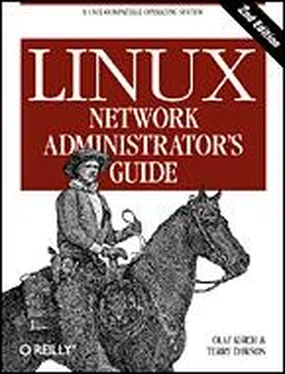IP addresses are split up into four eight-bit numbers called octets for readability. For example, quark.physics.groucho.edu has an IP address of 0x954C0C04 , which is written as 149.76.12.4 . This format is often referred to as dotted quad notation .
Another reason for this notation is that IP addresses are split into a network number, which is contained in the leading octets, and a host number, which is the remainder. When applying to the NIC for IP addresses, you are not assigned an address for each single host you plan to use. Instead, you are given a network number and allowed to assign all valid IP addresses within this range to hosts on your network according to your preferences.
The size of the host part depends on the size of the network. To accommodate different needs, several classes of networks, defining different places to split IP addresses, have been defined. The class networks are described here:
Class A
Class A comprises networks 1.0.0.0 through 127.0.0.0 . The network number is contained in the first octet. This class provides for a 24-bit host part, allowing roughly 1.6 million hosts per network.
Class B
Class B contains networks 128.0.0.0 through 191.255.0.0 ; the network number is in the first two octets. This class allows for 16,320 nets with 65,024 hosts each.
Class C
Class C networks range from 192.0.0.0 through 223.255.255.0 , with the network number contained in the first three octets. This class allows for nearly 2 million networks with up to 254 hosts.
Classes D, E, and F
Addresses falling into the range of 224.0.0.0 through 254.0.0.0 are either experimental or are reserved for special purpose use and don't specify any network. IP Multicast, which is a service that allows material to be transmitted to many points on an internet at one time, has been assigned addresses from within this range.
If we go back to the example in Chapter 1, we find that 149.76.12.4 , the address of quark , refers to host 12.4 on the class B network 149.76.0.0 .
You may have noticed that not all possible values in the previous list were allowed for each octet in the host part. This is because octets 0 and 255 are reserved for special purposes. An address where all host part bits are 0 refers to the network, and an address where all bits of the host part are 1 is called a broadcast address . This refers to all hosts on the specified network simultaneously. Thus, 149.76.255.255 is not a valid host address, but refers to all hosts on network 149.76.0.0 .
A number of network addresses are reserved for special purposes. 0.0.0.0 and 127.0.0.0 are two such addresses. The first is called the default route , and the latter is the loopback address . The default route has to do with the way the IP routes datagrams.
Network 127.0.0.0 is reserved for IP traffic local to your host. Usually, address 127.0.0.1 will be assigned to a special interface on your host, the loopback interface , which acts like a closed circuit. Any IP packet handed to this interface from TCP or UDP will be returned to them as if it had just arrived from some network. This allows you to develop and test networking software without ever using a "real" network. The loopback network also allows you to use networking software on a standalone host. This may not be as uncommon as it sounds; for instance, many UUCP sites don't have IP connectivity at all, but still want to run the INN news system. For proper operation on Linux, INN requires the loopback interface.
Some address ranges from each of the network classes have been set aside and designated "reserved" or "private" address ranges. These addresses are reserved for use by private networks and are not routed on the Internet. They are commonly used by organizations building their own intranet, but even small networks often find them useful. The reserved network addresses appear in Table 2.1.
Table 2.1: IP Address Ranges Reserved for Private Use
| Class |
Networks |
| A |
10.0.0.0 through 10.255.255.255 |
| B |
172.16.0.0 through 172.31.0.0 |
| C |
192.168.0.0 through 192.168.255.0 |
Now that you've seen how IP addresses are composed, you may be wondering how they are used on an Ethernet or Token Ring network to address different hosts. After all, these protocols have their own addresses to identify hosts that have absolutely nothing in common with an IP address, don't they? Right.
A mechanism is needed to map IP addresses onto the addresses of the underlying network. The mechanism used is the Address Resolution Protocol (ARP). In fact, ARP is not confined to Ethernet or Token Ring, but is used on other types of networks, such as the amateur radio AX.25 protocol. The idea underlying ARP is exactly what most people do when they have to find Mr. X in a throng of 150 people: the person who wants him calls out loudly enough that everyone in the room can hear them, expecting him to respond if he is there. When he responds, we know which person he is.
When ARP wants to find the Ethernet address corresponding to a given IP address, it uses an Ethernet feature called broadcasting , in which a datagram is addressed to all stations on the network simultaneously. The broadcast datagram sent by ARP contains a query for the IP address. Each receiving host compares this query to its own IP address and if it matches, returns an ARP reply to the inquiring host. The inquiring host can now extract the sender's Ethernet address from the reply.
You may wonder how a host can reach an Internet address that may be on a different network halfway around the world. The answer to this question involves routing , namely finding the physical location of a host in a network. We will discuss this issue further in the next section.
Let's talk a little more about ARP. Once a host has discovered an Ethernet address, it stores it in its ARP cache so that it doesn't have to query for it again the next time it wants to send a datagram to the host in question. However, it is unwise to keep this information forever; the remote host's Ethernet card may be replaced because of technical problems, so the ARP entry becomes invalid. Therefore, entries in the ARP cache are discarded after some time to force another query for the IP address.
Sometimes it is also necessary to find the IP address associated with a given Ethernet address. This happens when a diskless machine wants to boot from a server on the network, which is a common situation on Local Area Networks. A diskless client, however, has virtually no information about itself - except for its Ethernet address! So it broadcasts a message containing a request asking a boot server to provide it with an IP address. There's another protocol for this situation named Reverse Address Resolution Protocol (RARP). Along with the BOOTP protocol, it serves to define a procedure for bootstrapping diskless clients over the network.
We now take up the question of finding the host that datagrams go to based on the IP address. Different parts of the address are handled in different ways; it is your job to set up the files that indicate how to treat each part.
When you write a letter to someone, you usually put a complete address on the envelope specifying the country, state, and Zip Code. After you put it in the mailbox, the post office will deliver it to its destination: it will be sent to the country indicated, where the national service will dispatch it to the proper state and region. The advantage of this hierarchical scheme is obvious: wherever you post the letter, the local postmaster knows roughly which direction to forward the letter, but the postmaster doesn't care which way the letter will travel once it reaches its country of destination.
Читать дальше



![Andrew Radford - Linguistics An Introduction [Second Edition]](/books/397851/andrew-radford-linguistics-an-introduction-second-thumb.webp)








